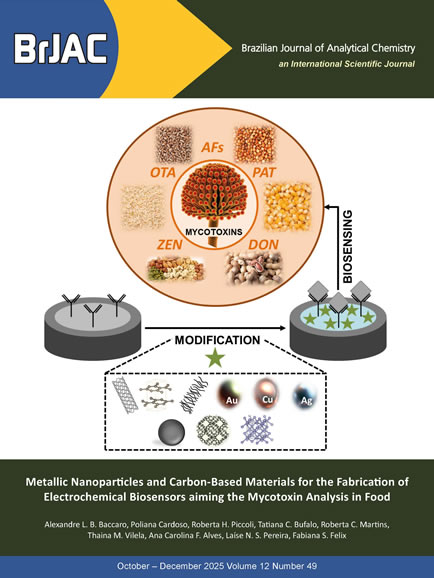Metallic Nanoparticles and Carbon-Based Materials for the Fabrication of Electrochemical Biosensors aiming the Mycotoxin Analysis in Food
Alexandre L. B. Baccaro, Poliana Cardoso, Roberta H. Piccoli, Tatiana C. e Bufalo, Roberta C. Martins, Thaina M. Vilela, Ana Carolina F. Alves, Laíse N. S. Pereira, Fabiana S. Felix
Abstract: Mycotoxins are low molecular-weight compounds produced by fungi genera as secondary metabolites during pre- and post-harvest storage of crops and foodstuff. Many reports show highly concerning issues ascribed to their carcinogenic, genotoxic, immunosuppressive, and teratogenic properties. Biosensors are compact analytical devices incorporating a biological or biologically-derived recognition element that might be either integrated within or intimately associated with a physicochemical transducer. The most applied bioreceptors are the enzymes (biosensors), DNA and RNA nucleic acids (genosensors), antibodies (immunosensors), aptamers (aptasensors) or living cells (microbial biosensors). The integration of nanotechnology to the biosensors field brought sensitivity and versatility for bioassays, since nanomaterials might play the role as new signal markers, surface subtracts for functionalization and fixation of biomolecules, and generation source of analytical signals. For electrochemical biosensors, nanostructures can enhance the sensitivity of electrochemical techniques by filling the gap between the converter and the biorecognition element. Metal nanoparticles are used to improve the analytical sensitivity by refining the electrical connectivity of the interface, increasing both the chemical accessibility of analytes and the sensing surface with higher amounts of bioaffinity recognition sites. Gold nanoparticles are among the most used nanostructures due to its unique electrocatalytic activity and conductivity. In turn, carbon-based nanomaterials are very appealing considering their large specific surface area and high electron transfer rates. Carbon nanotubes (CNTs) and graphene oxide materials are the most employed carbon-based materials. There is no doubt that the whole bioassay has become more versatile, robust, and dynamic with the introduction of the nanoscience, consolidating in an emerging field with current intense research. Hence, this work reviews some selected applications of electrochemical metallic and carbon-based nanobiosensors for the determination of mycotoxins in food, revisiting important fundamentals of the electrochemical bioassay.
Read more




























